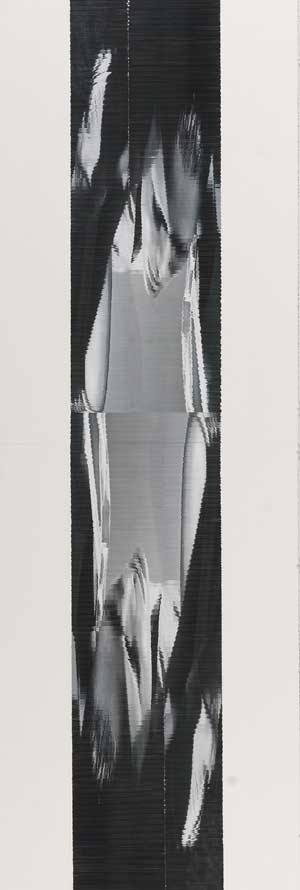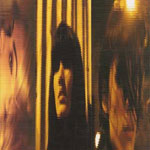John Sparagana is known for his appropriation of tear sheets from fashion and cultural magazines, which he manipulates in such a way as to transform their surfaces and explore their meaning. In his earlier Sleeping Beauty series, Sparagana folded, crushed and otherwise distressed the actual pages of magazines until they deteriorated, their contents fading into ghostly shapes. The resulting scenes" fracturing by fine lines brought to mind the craquelure finish of a Renaissance masterpiece.

John Sparagana...They Call Us Up Just to See if They Can...Burn Us Down, 2006...graphite, magazine pages...and archival adhesive on paper...46 1/2 x 30 inches...
Through Sparagana's handling, the glossy clarity of the photographs dissolved into a soft and ragged — almost clothlike — texture. The series revealed the medium's ephemeral nature while hinting at the persistence of its messages about beauty and consumption. Sparagana often left a portion of each magazine undamaged; the juxtaposition suggested both a gravity and an ethereality not immediately discernible in the original images.
For What the Child Saw, What the Lover Saw, What the Killer Saw at Monique Meloche Gallery, Chicago, Sparagana addressed the same subject on a grander scale by enlarging his magazine images and slicing them into minute, unidirectional strips. He then reassembled the strips into playful extensions, multiplications and hybridizations by interpolating sections from noncontiguous parts of the image or by mixing two or more images together. The process stretches and splits the subjects (mainly fashion models) until they vibrate, disintegrate and reconstitute themselves. The distortions in one piece, The Sixteen Foot Golden Body, render individuality and even gender indeterminate, distancing the images from their former, self-consciously gendered contexts. Sparagana's method also invests the pages with desperate, and even comedic, overtones. Full Fathom Five elongates an advertisement for sunglasses until the models" mouths distend in apparent horror. Another piece joins faces from a Benetton advertisement by means of alternating strips; it gestures at Benetton's "United Colors" campaign while contorting the models into grotesques. To his credit, Sparagana's ironic stance is complicated by his obvious fascination with such throwaway visual culture. And no wonder: although omnipresent to the point of mundanity, these images reflect some of our society's most visceral fantasies and fears.

John Sparagana...Afternoon Halluncinogenic...2006...graphite, magazine pages...and archival adhesive on paper...88 x 29 1/2 inches...
Some of Sparagana's conclusions are too obvious, as in two works that integrate fashion spreads and photographs of what appears to be George Bush. One piece knits a Chanel advertisement with the president's face, which is underscored by a snippet of text that reads "Death" (hence the title, Chanel of Death ). If anything more than a banal critique of the present political climate is intended, the predictability of the selections — as well as the transparency of titles such as Vampire Empire — obscure it.
At its best, Sparagana's approach lends dimensionality to bodies that are often idealized and airbrushed out of time and space. Man Is in Love and Loves What Burns functions as a bridge between Sparagana's earlier work and the present series, making use of both a segmented and a lightly distressed tableau. The original advertisement pictured a shirtless model as he leaned forward to kiss a beautiful woman in a gold-sequined top. Here, Sparagana's manipulations suspend time. The artist has escalated the drama of the narrative, foregrounding the beauty of the bodies and the richness of the scene, all the while raising the possibility that something is amiss in the image and in our attraction to it. While this show was not as successful or as lovely as some of his previous exhibitions, images such as this one uphold the value and appeal of Sparagana's work.
Sparagana is often discussed in the context of "fair use" (that is, the extent to which copyrighted items may be used without express permission) due to his unapologetic use of proprietary materials. Sparagana also challenges intellectual property law by photographing his hand-worked magazine pages, which he then brands with his own signature and copyright (a project that echoes earlier work by Richard Prince and Sherrie Levine). Such provocations raise important and unsettled questions: How substantially must an artist alter an object to elevate it from the merely commercial to fine art? What do artists owe to the producers of mass culture? Given the copyright infringement lawsuits leveled at Jeff Koons, Philip Lorca di Corcia and others in recent years, Sparagana's method represents a timely contribution to the debate.
The images in What the Child Saw… necessarily interrogate surfaces: the slick coating of magazine pages, the physiques of models, the products that consumers are persuaded to buy. Like Graham Little, whose luminous drawings also appropriate and reinvent fashion spreads, Sparagana is often understood as a subtle critic of high style. Yet in both cases any criticism is inseparable from the pleasures derived from the artists" raw materials. Both artists question a culture of capitalism, consumerism and beauty idealism, but for better or worse, their work cannot help but embody the same. What is even more unsettling is the way in which these artists implicate viewers in their dilemma. Along with them, the viewer cannot escape the pleasures of seeing beautiful surfaces and the impulse, whether by physical or metaphorical means, to grasp that beauty in our hands.
Images courtesy Monique Meloche Gallery.
Leah DeVun is a writer living in Houston.



